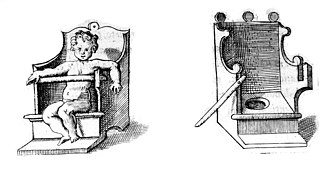
Toilet humour, or potty or scatological humour, is a type of off-colour humour dealing with defecation, diarrhea, constipation, urination and flatulence, and to a lesser extent vomiting and other bodily functions.
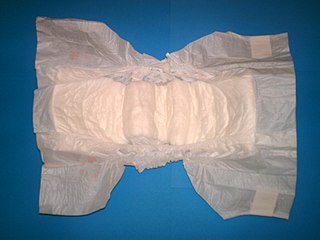
A diaper or a nappy is a type of underwear that allows the wearer to urinate or defecate without using a toilet, by absorbing or containing waste products to prevent soiling of outer clothing or the external environment. When diapers become wet or soiled, they require changing, generally by a second person such as a parent or caregiver. Failure to change a diaper on a sufficiently regular basis can result in skin problems around the area covered by the diaper.
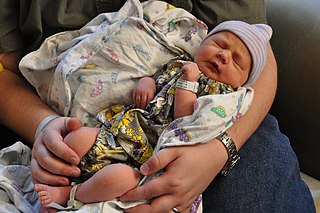
An infant or baby is the very young offspring of human beings. Infant is a formal or specialised synonym for the common term baby. The terms may also be used to refer to juveniles of other organisms. A newborn is, in colloquial use, an infant who is only hours, days, or up to one month old. In medical contexts, a newborn or neonate is an infant in the first 28 days after birth; the term applies to premature, full term, and postmature infants.

Defecation follows digestion, and is a necessary process by which organisms eliminate a solid, semisolid, or liquid waste material known as feces from the digestive tract via the anus or cloaca. The act has a variety of names ranging from the common, like pooping or crapping, to the technical, e.g. bowel movement, to the obscene (shitting), to the euphemistic, to the juvenile. The topic, usually avoided in polite company, can become the basis for some potty humor.
Elimination communication (EC) is a practice in which a caregiver uses timing, signals, cues, and intuition to address an infant's need to eliminate waste. Caregivers try to recognize and respond to babies' bodily needs and enable them to urinate and defecate in an appropriate place. Caregivers may use diapers (nappies) as a back-up in case of "misses" some or all of the time, or not at all. EC emphasizes communication between the caregiver and child, helping them both become more attuned to the child's innate rhythms and control of urination and defecation. The term "elimination communication" was inspired by traditional practices of diaperless baby care in less industrialized countries and hunter-gatherer cultures. Some practitioners of EC begin soon after birth, the optimum window being zero to four months in terms of helping the baby get in tune with their elimination needs, although it can be started with babies of any age. The practice can be done full-time, part-time, or just occasionally.
A toddler is a child approximately 1 to 3 years old, though definitions vary. The toddler years are a time of great cognitive, emotional and social development. The word is derived from "to toddle", which means to walk unsteadily, like a child of this age.

Nocturnal enuresis (NE), also informally called bedwetting, is involuntary urination while asleep after the age at which bladder control usually begins. Bedwetting in children and adults can result in emotional stress. Complications can include urinary tract infections.
Encopresis is voluntary or involuntary passage of feces outside of toilet-trained contexts in children who are four years or older and after an organic cause has been excluded. Children with encopresis often leak stool into their undergarments.
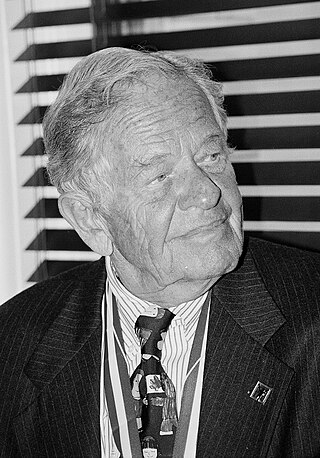
Thomas Berry Brazelton was an American pediatrician, author, and the developer of the Neonatal Behavioral Assessment Scale (NBAS). Brazelton hosted the cable television program What Every Baby Knows, and wrote a syndicated newspaper column. He wrote more than two hundred scholarly papers and twenty-four books.
The anal stage is the second stage in Sigmund Freud's theory of psychosexual development, taking place approximately between the ages 18 months and three years. According to Freud, the anus is the primary erogenous zone and pleasure is derived from controlling bladder and bowel movement. The major conflict issue during this stage is toilet training. A fixation at this stage can result in a personality that is too rigid or one that is too disordered.

Training pants are undergarments used by incontinent people, typically toddlers, as an aid for toilet training. They are intended to be worn in between the transition between wearing diapers but before they are ready to wear regular underpants. Training pants may be reusable and made of fabric, or they may be disposable. In the US, disposable training pants may also be referred to as "pull-ups", and in the UK, training pants are frequently referred to as nappy pants or trainer pants. The main benefit of training pants over diapers is that unlike traditional diapers, they can be easily pulled down in order to sit on a potty or toilet, and pulled back up for re-use after the person has used the toilet. The main benefit of wearing training pants over regular underpants is that if the person has an accident, they do not soil their environment.
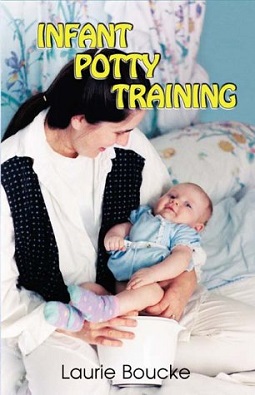
Infant Potty Training: A Gentle and Primeval Method Adapted to Modern Living is a book about toilet training by Laurie Boucke. It is an expansion of ideas that were originally presented in a small self-published volume called Trickle Treat in 1991. Infant Potty Training was first published in 2000, is now in its third edition (2008), and has editions in German, Dutch, Italian and Japanese. Infant potty training is traditionally used in at least 80 countries.
Sleep training is a set of parental intervention techniques with the end goal of increasing nightly sleep in infants and young children, addressing “sleep concerns”, and decreasing nightime signalling. Although the diagnostic criteria for sleep issues in infants is rare and limited, sleep training is usually approached by parent(s) or caregivers self identifying supposed sleep issues.
Suprapubic aspiration is a procedure to take a urine sample. It involves putting a needle through the skin just above the pubic bone into the bladder. It is typically used as a method to collect urine in child less than 2 years of age who is not yet toilet trained in an effort to diagnose a urinary tract infection.

Open-crotch pants, also known as open-crotch trousers or split pants, are worn by toddlers throughout mainland China. Often made of thick fabric, they are designed with either an unsewn seam over the buttocks and crotch or a hole over the central buttocks. Both allow children to urinate and defecate without the pants being lowered. The child simply squats, or is held by the parent, eliminating the need for diapers. The sight of the partially exposed buttocks of kaidangku-clad children in public places frequently astonishes foreign visitors, who often photograph them. They have been described as being "as much a sign of China as Chairman Mao's portrait looming over Tiananmen Square."
A wetness indicator is a common feature in many disposable diapers and toilet training pants. It is a feature that reacts to exposure of liquid as a way to discourage the wearer to urinate in the training pants, or as an indicator to a caregiver that a diaper needs changing.
Baby-led potty training is a system for meeting babies' toileting needs. The main feature of the system is that care-givers 'hold babies out' or support them on a potty in order for them to void in an appropriate place outside their nappy. The method is typically started before the baby is six months old. Care-givers use a combination of timing, and observing babies' own signals, to decide when to hold them out. In many countries it is the norm for parents to care for their babies without nappies from the first days of life. The term Baby-led potty training describes the method being used by a growing number of families in the UK. It is an adaptation of the techniques used in Africa, India and China amongst others, to fit into a modern Western life-style. It is similar to the US movement Elimination Communication, though UK proponents of the method emphasise its pragmatic approach with no strict rules, and it can be used by any type of parent. Some parents use the technique just occasionally, others as an alternative to full-time nappies, and some as a route to toilet independence.
Diaper need is the struggle to provide a sufficient number of clean diapers to ensure that each diaper user can be changed out of wet or soiled diapers as often as necessary. An adequate supply of diapers is a basic need for all infants, as necessary for health and well-being as food and shelter. Adults and older children experiencing incontinence may also suffer from diaper need if they or their caretakers cannot acquire an adequate supply.
Constipation in children refers to the medical condition of constipation in children. It is a functional gastrointestinal disorder.
Newborn care and safety are activities and precautions recommended for new parents or caregivers. It is an educational goal of many hospitals and birthing centers to promote newborn care and safety as parents take their infant home.

